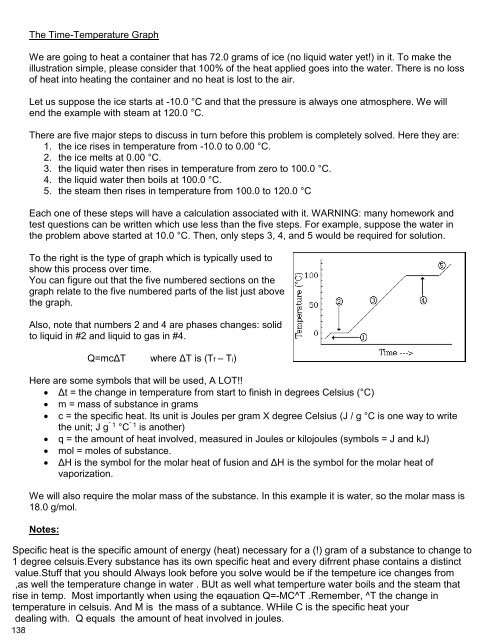You also want an ePaper? Increase the reach of your titles
YUMPU automatically turns print PDFs into web optimized ePapers that Google loves.
Structure effects: determines what kind of substance will be able to dissolve the sample.<br />
hydrophobic - water-fearing pressure affect more gasses than it does to liquids.<br />
hydrophilic - water-loving<br />
While pressure has little effect on the solubilities of solids or liquids, it does significantly increase the<br />
solubility of a gas.<br />
Pressure effects: gas solubility increases with increased pressure.<br />
Henry's Law: the amount of a gas dissolved in a solution is directly proportional to the pressure of the<br />
gas above the solution.<br />
P = kC<br />
P represents the partial pressure of the gas, C represents the concentration of the dissolved gas, k is<br />
a constant of the particular solution.<br />
Solubility and Pressure are Directly Related<br />
Dilution is the process of decreasing the concentration of a solute in solution, usually simply by mixing<br />
with more solvent. To dilute a solution means to add more solvent without the addition of more solute.<br />
The resulting solution is thoroughly mixed so as to ensure that all parts of the solution are identical.<br />
Temperature effects - the solubility of most solids increases with temperature.<br />
Inverse relatiion ship. One goes up the other ggoes down,<br />
The Vapor Pressures of Solutions<br />
Volatile - quantified by the tendency of a substance to vaporize. Volatility is directly related to a<br />
substance's vapor pressure. At a given temperature, a substance with higher vapor pressure<br />
vaporizes more readily than a substance with a lower vapor pressure.<br />
Nonvolatile - does not readily form a vapor.<br />
Nonvolatile solutes lowers the vapor pressure of a solvent. The nonvolatile solute decreases the<br />
number of solvent molecules per unit volume. Thus it lowers the number of solvent molecules at the<br />
surface, and it should proportionately lower the escaping tendency of the solvent molecules.<br />
Boiling-Point elevation and Freezing-Point Depression<br />
Colligative properties - depend on the number, and not the identity of the solute particles in an ideal<br />
solution. ex. - freezing-point depression and boiling-point elevation.<br />
Boiling-point elevation - a nonvolatile solute elevates the boiling point of the solvent.<br />
Freezing-point depression - the water in the solution has a lower vapor pressure than that of pure ice.<br />
http://slideplayer.com/slide/10775304/<br />
Putting salt makes it less likely to be melted next time in the salt.<br />
135



